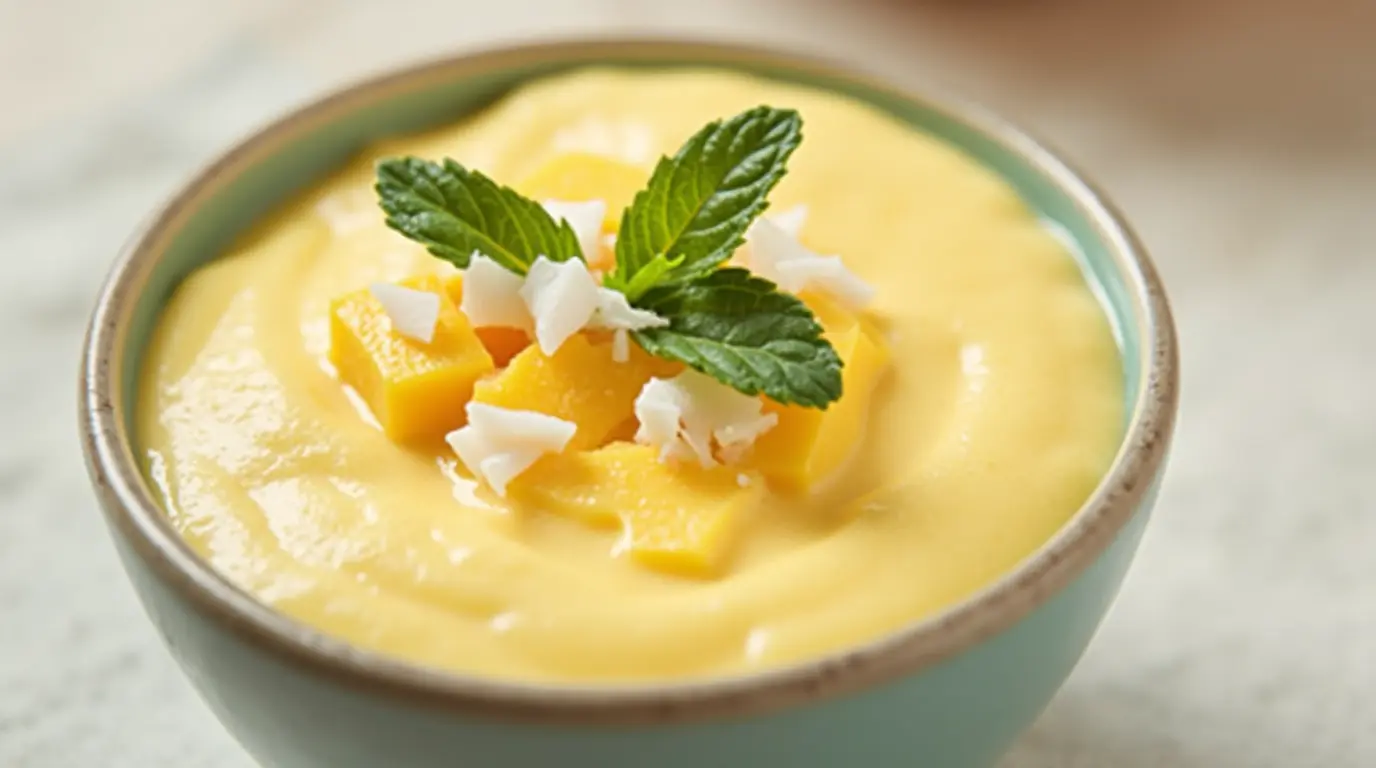Sweet, creamy, and bursting with tropical flavor, mango mousse is the kind of dessert that feels like a vacation in a cup.
But what’s behind that silky texture and bright taste? This post breaks down the few key ingredients that make mango mousse so light, luscious, and irresistible.
Table of contents
Overview of Mango Mousse
What is Mango Mousse?
Mango mousse is a creamy and fluffy dessert that features the rich flavor of ripe mangoes. The mousse is made by blending mango puree with whipped cream, sugar, and a setting agent like gelatin or agar-agar. The result is a smooth, velvety dessert that melts in your mouth, offering a perfect balance of sweetness and texture.
Popularity and Appeal of Mango Mousse
Mango mousse has gained popularity worldwide due to its refreshing taste and versatility. It can be served on its own, layered in parfaits, or used as a filling for cakes and pastries. The vibrant color and tropical flavor of mango mousse make it a visually appealing and delicious choice for dessert lovers.
If you’re a fan of fruity sweets, explore more mango desserts and tropical treats for sunny flavor all year round.
Key Ingredients
Essential Components of Mango Mousse
Mangoes
Mangoes are the star ingredient in mango mousse, providing the distinctive tropical flavor and vibrant color. Using ripe and juicy mangoes ensures a sweet and flavorful mousse.
– Types of Mangoes Suitable for Mousse
Different varieties of mangoes can be used to make mango mousse, such as Alphonso, Ataulfo, or Haden. These varieties are known for their rich, sweet flavor and smooth texture, making them ideal for desserts. It’s important to choose mangoes that are fully ripe to ensure the best taste and consistency.
– Preparing Mangoes for the Mousse
To prepare mangoes for the mousse, start by peeling and slicing them. Remove the pit and cut the mango flesh into chunks. Blend the mango chunks into a smooth puree, ensuring there are no lumps. For an extra smooth texture, you can strain the puree through a fine sieve to remove any fibers.
Whipping Cream
Whipping cream is essential for giving mango mousse its light and airy texture. The cream is whipped to incorporate air, creating a fluffy base for the mousse.
– Selecting the Right Cream
Choose a heavy whipping cream with a high fat content (around 35% or higher) for the best results. The higher fat content helps the cream whip up to a stable, airy consistency, which is crucial for a light mousse.
– Whipping Techniques
To whip the cream, start with cold cream and a chilled bowl and whisk. Whip the cream on medium-high speed until it forms stiff peaks, being careful not to overwhip, which can cause the cream to become grainy and turn into butter.
Sugar
Sugar adds sweetness to the mousse, balancing the tartness of the mangoes and enhancing their natural flavor.
– Adjusting Sweetness to Taste
The amount of sugar needed can vary depending on the sweetness of the mangoes and personal preference. Start with a small amount and adjust to taste, ensuring the mousse is sweet but not overly sugary.
Gelatin or Agar-Agar
Gelatin or agar-agar is used to set the mousse, giving it a firm yet creamy texture.
– Role in Setting the Mousse
Gelatin is a common setting agent in desserts, providing a smooth and stable consistency. Agar-agar, a plant-based alternative, works similarly and is suitable for vegetarian or vegan diets.
– Vegan Alternatives
For a vegan version of mango mousse, agar-agar is an excellent substitute for gelatin. It is derived from seaweed and sets the mousse in a similar way to gelatin. Follow the package instructions for the correct ratio and preparation methods.
You can also layer mango mousse with flaky puff pastry for a refined dessert presentation
Additional Ingredients and Variations
Enhancing the Flavor and Texture
Lemon or Lime Juice
Adding a splash of lemon or lime juice to mango mousse can enhance its flavor by providing a zesty contrast to the sweetness of the mangoes. The acidity from the citrus fruits brightens the overall taste and adds a refreshing element to the dessert.
– Adding a Zesty Flavor
Lemon or lime juice should be added in moderation, as too much can overpower the natural sweetness of the mangoes. Typically, the juice of half a lemon or lime is sufficient for a batch of mousse. Mix it into the mango puree before combining with the other ingredients.
Vanilla Extract
Vanilla extract is a common addition to many desserts, and mango mousse is no exception. It adds depth and complexity to the flavor profile, enhancing the overall taste without being overpowering.
– Depth of Flavor
Just a teaspoon of high-quality vanilla extract can elevate the mousse by adding a subtle, aromatic note. If possible, use pure vanilla extract instead of artificial flavoring for the best results.
Mint or Basil Leaves
Fresh mint or basil leaves can be used as garnishes for mango mousse, adding a touch of color and a hint of herbal freshness. These herbs not only enhance the visual appeal of the dessert but also provide an additional layer of flavor.
– Garnishing Ideas
Mint leaves can be placed on top of each serving of mousse for a classic look, while basil leaves can be finely chopped and sprinkled for a more sophisticated presentation. Both herbs pair well with the tropical flavor of mangoes.
Optional Add-Ins
While traditional mango mousse is delicious on its own, you can experiment with additional ingredients to create unique variations.
– Coconut Milk for a Tropical Twist
Adding a small amount of coconut milk to the mango puree can give the mousse a richer, more tropical flavor. This twist complements the mango and can make the dessert even more indulgent. Use about 1/4 cup of coconut milk for a batch of mousse, adjusting to taste.
Step-by-Step Preparation
How to Make Mango Mousse
Preparing the Mango Puree
Start by choosing ripe, sweet mangoes. Peel the mangoes and remove the pits. Cut the flesh into chunks and blend it in a food processor or blender until smooth. For an extra smooth texture, you can strain the puree through a fine sieve to remove any fibrous parts. This step is crucial to ensure the mousse has a silky consistency.
Whipping the Cream
Chill your mixing bowl and whisk in the refrigerator for about 15 minutes before you begin. Pour the heavy whipping cream into the chilled bowl and whisk on medium-high speed until stiff peaks form. Be careful not to overwhip the cream, as it can turn into butter. The whipped cream should be airy and stable, ready to be folded into the mango puree.
Combining Ingredients
In a large mixing bowl, gently fold the mango puree into the whipped cream. Use a spatula to combine the mixture, taking care not to deflate the whipped cream.
If using gelatin, dissolve it in warm water according to the package instructions and let it cool slightly before adding it to the mixture. For agar-agar, follow the same procedure.
Stir the mixture until all ingredients are fully incorporated, ensuring a smooth and even consistency.
Setting the Mousse

Pour the mango mousse mixture into individual serving dishes or a large bowl. Smooth the top with a spatula. Cover the dishes with plastic wrap and refrigerate for at least 4 hours, or until the mousse is set. The setting agent (gelatin or agar-agar) will help the mousse firm up, resulting in a light and creamy texture.
Serving Suggestions
Before serving, you can garnish the mango mousse with fresh mint leaves, a dollop of whipped cream, or thin slices of mango. These garnishes add a decorative touch and enhance the presentation of the dessert. Serve the mousse chilled to enjoy its refreshing and smooth texture.
Tips and Tricks
Perfecting Your Mango Mousse
Achieving the perfect mango mousse requires attention to detail and a few helpful tips. Here are some expert tips to ensure your mousse turns out light, airy, and delicious.
Tips for Achieving the Perfect Texture
- Chill Your Tools: Ensure that your mixing bowl and whisk are well-chilled before whipping the cream. This helps the cream whip up faster and achieve a stable texture.
- Use Ripe Mangoes: Fully ripe mangoes provide the best flavor and sweetness. Avoid using mangoes that are overripe or underripe, as they can affect the taste and texture of the mousse.
- Fold Gently: When combining the mango puree with the whipped cream, use a gentle folding motion. This helps maintain the airiness of the cream and prevents it from deflating.
- Strain the Mango Puree: For an extra smooth mousse, strain the mango puree to remove any fibrous parts. This ensures a silky consistency in the final dessert.
Common Mistakes to Avoid
- Overwhipping the Cream: Overwhipping can cause the cream to become grainy or turn into butter. Stop whipping as soon as stiff peaks form.
- Using Warm Ingredients: Ensure all ingredients are properly chilled before use. Warm ingredients can affect the setting process and the texture of the mousse.
- Skipping the Setting Agent: Gelatin or agar-agar is crucial for setting the mousse. Skipping this ingredient can result in a runny dessert that lacks structure.
Storing and Serving
- Refrigeration: Mango mousse should be refrigerated for at least 4 hours to set properly. You can prepare it a day in advance and store it in the refrigerator until ready to serve.
- Serving Temperature: Serve the mousse chilled for the best texture and flavor. Avoid letting it sit at room temperature for too long, as it can lose its firmness.
- Garnishing: Garnish the mousse with fresh mango slices, mint leaves, or a dollop of whipped cream just before serving. This adds a decorative touch and enhances the presentation.
Mango mousse can be considered a rich dessert, but one that offers both flavor and some nutritional perks.
Frequently Asked Questions
Can I use canned mango instead of fresh?
Yes! Canned mango pulp works great and offers consistent sweetness. Just make sure it’s unsweetened if you want full control over the sugar.
Does mango mousse need gelatin?
It depends. Some recipes use gelatin for a firmer set, but many rely on whipped cream or whipped egg whites for a light, airy texture — no gelatin needed.
How long does mango mousse last in the fridge?
Mango mousse keeps well for up to 3 days in the fridge. Store it in an airtight container to maintain freshness and texture.
Can I make mango mousse dairy-free?
Absolutely. Use coconut cream or a dairy-free whipped topping as a substitute for heavy cream, it adds extra tropical flair, too.

